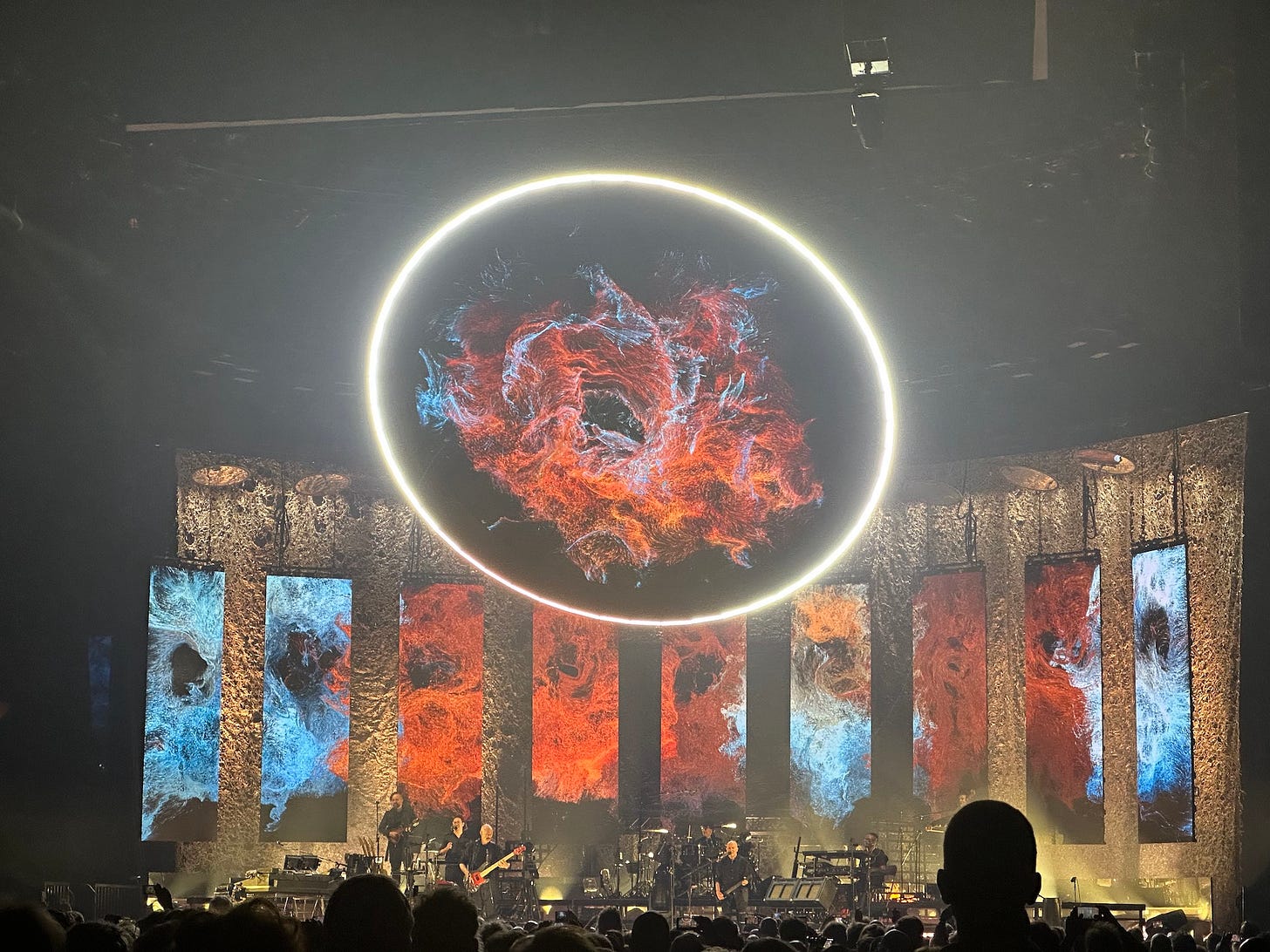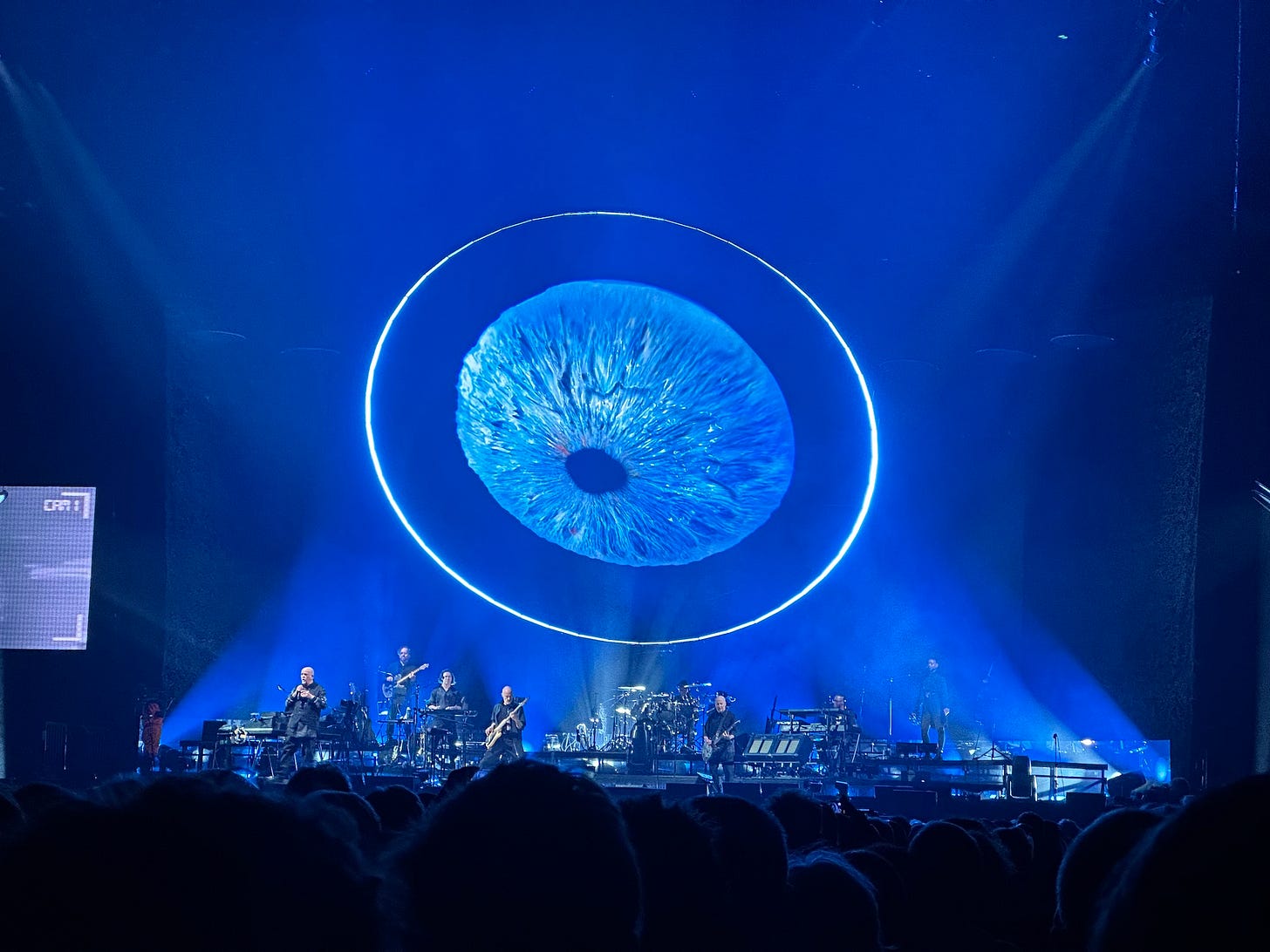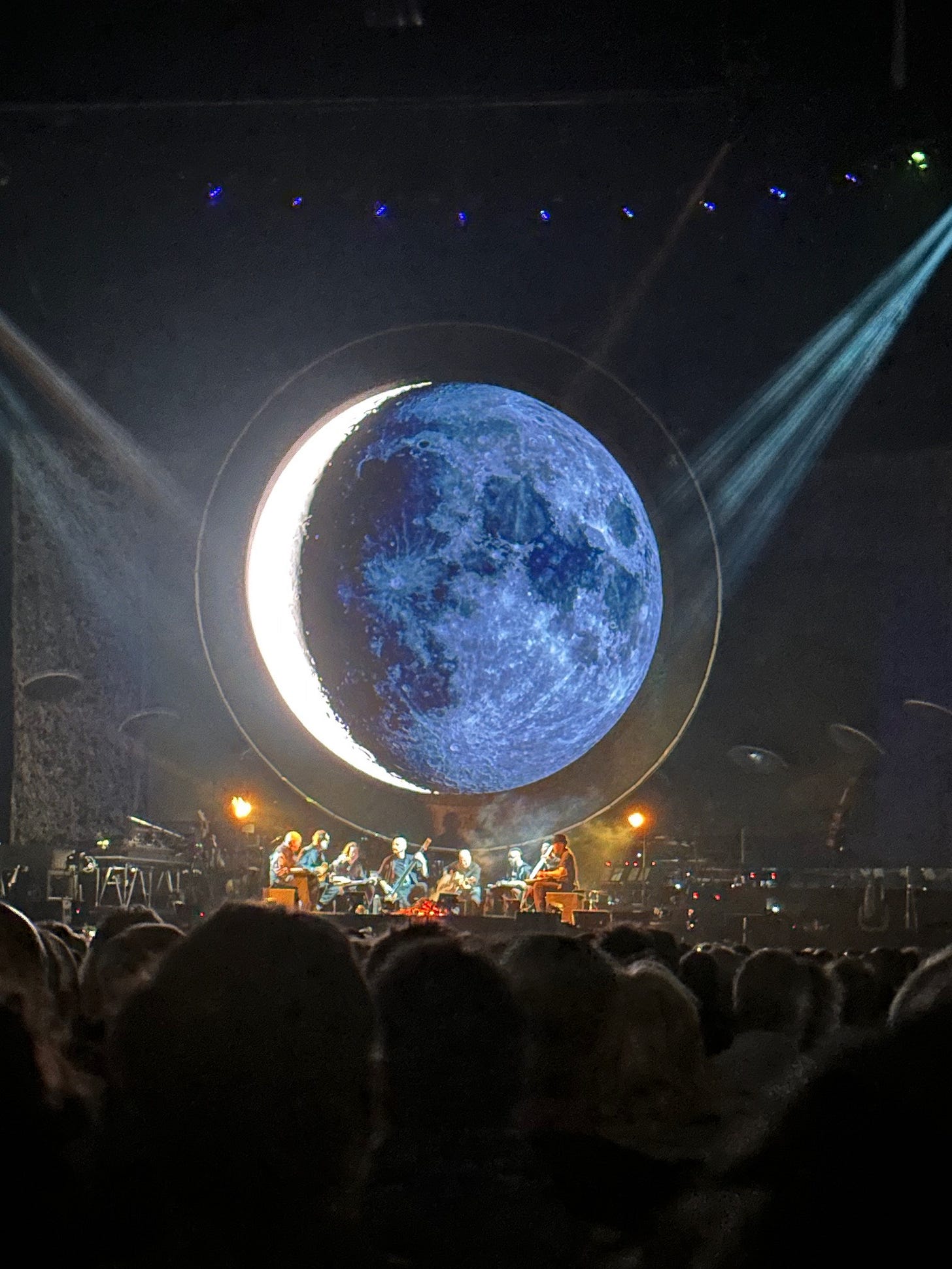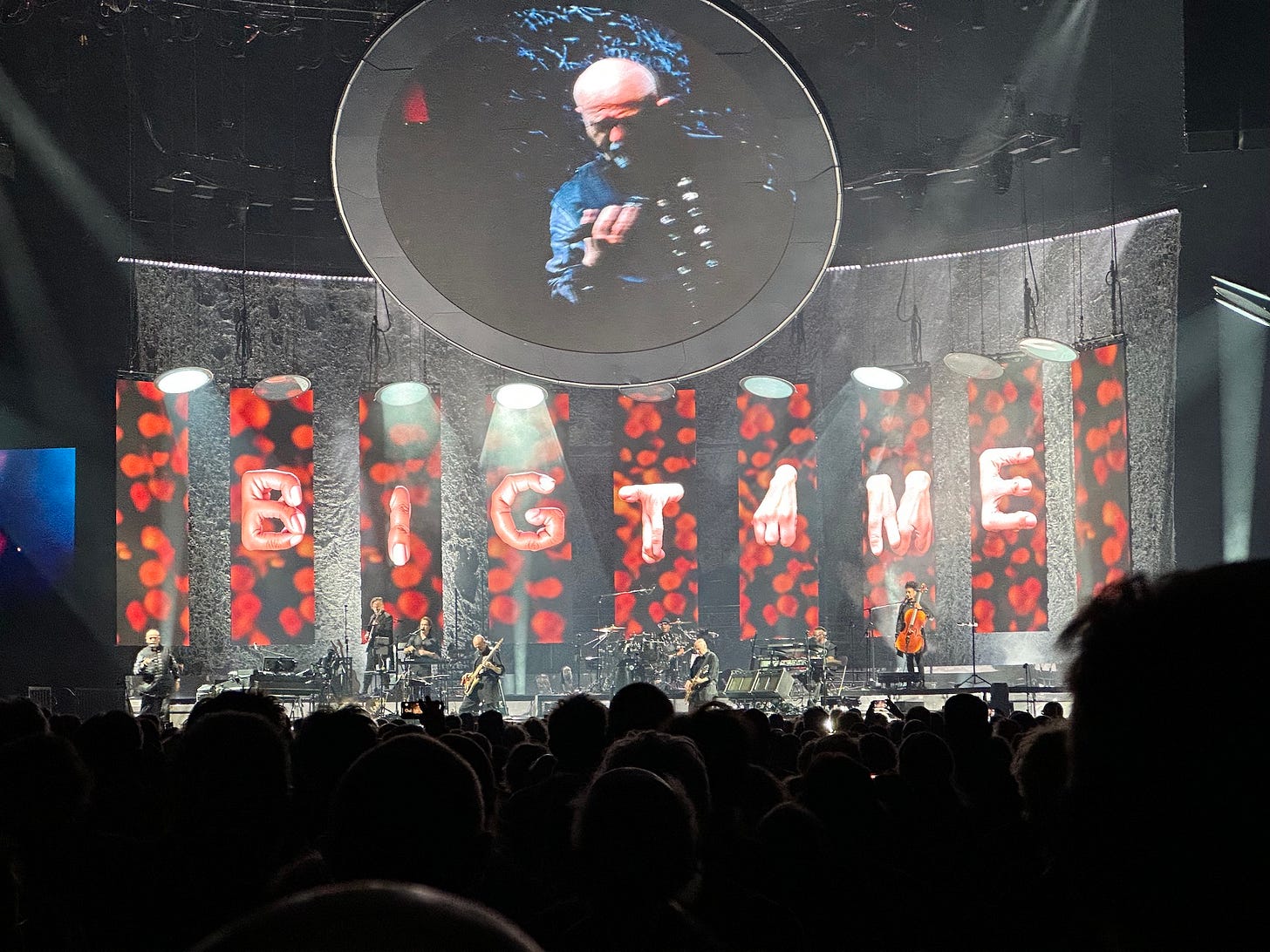Peter Gabriel @ Ziggodome, Monday June 5, 2023
Where occassionally the perfect synergy between sound, sight & social engagement arose
Nowadays, it’s a rare artist who started in the 70s who does not rely on their greatest hits. It’s an even rarer artist who plays all the songs of their latest album. And it’s only Peter Gabriel1 who plays all the songs from a new album (called i/o, and released song by song on his website) that hasn’t been officially released yet (even though about half of the tracks were released online by the time of the concert). Even in the autumn of his long carreer, Peter Gabriel is still full of chutzpah.
In general, a few observations.
Peter Gabriel knows how to put up a show. The visual aspect was just as important as the audio one (for which he gathered a mix of old band-mates Tony Levin, David Rhodes and Manu Katché; and newer artists Ayanna Witter-Johnson, Marina Moore, Richard Evans and Josh Shpak) with both elements complementing each other throughout. He also knows how to build up a set, starting out with restraint and gradually introducing and revealing more parts of the light show.
Like Kate Bush—who I was happy to see in one of her Hammersmith Odeon shows in 2016—his set is a balance between dark and light, between down- and upbeat. Both artists—and I know it’s deliberate in Kate Bush’s case, as she mentioned it in her tour book—put a high import on balance, and thereby evade the all too English way of embracing doom, reverting to cynicism and wallowing in bleakness2. Prime example: when Gabriel introduces “Panopticom” and mentions that AI can also be used for the good.
Finally, he’s still an incredible performer. I’ll be hard-pushed to think of someone who is so at ease on a stage in front of a large audience. Not that he constantly tries to draw all attention to him, as he often gets behind his keyboard, or even leaves the stage to let other players shine. He also introduces all players (at least twice) and calls for a heartfelt thanks for the road crew. Inescapably, though, much of the focus falls on the singer, main composer and performer, but he carries that role with verve and grace, and is not afraid of some self-deprecation:
“You know when Abba used avatars, these looked twenty years younger and ten kilograms lighter than the actual persons. Well, I’m doing the same, but then in reverse: my avatar is twenty years older and ten kilograms heavier.”
“This song is from the time when Tony (bass player Tony Levin) and I still had hair.”
(I paraphrase, but that was the gist.)
As a writer, I was very happy to see that the fist visual during the song “This is Home” (from i/o) was of a house filled with books. Also, as a writer of optimistic science fiction, I was happy that he meantioned that AI—the talk of the town right now, even if it’s not truly intelligent—might also be used for the good in his introduction to the song “Panopticom”.
Of course, Gabriel did not skip his greatest hits. “Big Time”, “Don’t Give Up” and “Sledgehammer”—all from “So”—were there, but spread out over the setlist, probably in order to give the new songs some breathing room. It was quite effective, at that.
The show started gently, with the band gradually gathering around a campfire and a giant moon during “Washing of the Water”. Then, after “Growing Up”, the first setlist was mainly new songs from i/o. I didn’t know these songs, and it’s hard to judge them live when you hear them for the first time. Impression: many of them were relatively restrained, often ballads.
It’s not that Gabriel’s ballads are bad, they’re quite good. It’s that they don’t unleash the full potential of Gabriel’s artistry. No, the magical moments happened when the full band was playing—Gabriel utilising the full potential of his musicians—in combination with the visual aspect—and Gabriel sure knows how to accompany a song with appropriate and delightful visuals—and a song that’s not only fantastically crafted, but has something profound to say, as well.
In my opinion, there were four songs that rose to that level. First in the set was “Road to Joy”, a new song from i/o that I didn’t know. It builds up gradually until the point of exclamation (for lack of a better word), where suddenly the whole band sets in, the volume doubles, the light show goes full throttle and—equally as important—Gabriel puts the power of conviction in his voice.
The second moment suprême3 was “Red Rain”, with a starring role for drummer Manu Katché. “Red Rain” is—if I understand it correctly—based on a nightmare Gabriel had about the parting of a vast, red sea4 and human-like glass bottles filling with blood. A metaphor for a destructive world full of torture and kidnapping, possibly a metaphor for all the suffering in the world5. During the song, the visuals are quite restrained, switching from light blue in the verses to a blood red backdrop mimicking, indeed, ‘red rain’, yet surprisingly effective in its clarity.
The third was—inevitably—“Solsbury Hill” (which I consider his best song). See the video for the atmosphere. There was no way anybody was staying in their seats.
The fourth—and last encore of the show—was, just as unevitable, “Biko”. “Biko” is a stellar example of a song that works because of its simplicity. A straightforwardness powered by the intensity of its humanitarian and political engagement. The light show matched this simplicity as it displayed a red circle gradually revealing Steve Biko’s face. Personal note: my late father worked in South Africa during apartheid (he supervised the construction of beverage production lines), and he was so appalled at the treatment of black people that he got physically sick from it. He told me of those apartheid horrors when he returned, and our family has been staunchly anti-apartheid ever since. My father died in 1986, and I still regret that he didn’t live to see the end of aparthied when Nelson Mandela was freed. As such, I consider “Biko” one of the greatest protest songs of my generation. White man’s guilt, I know. But without white man’s guilt—see also the ‘The Pacific Jurnal of Adam Ewing’ sections of David Mitchell’s CLOUD ATLAS—slavery might have never been abolished6.
Setlist:
Set 1:
Washing of the Water (Us);
Growing Up (Us);
Panopticom (i/o);
Four Kinds of Horses (i/o)
i/o (i/o);
Digging in the Dirt (Us);
Playing for Time (i/o);
Olive Tree (i/o);
This is Home (i/o);
Sledgehammer (So);
—break—
Darkness (Us);
Love Can Heal (i/o);
Road to Joy (i/o);
Don’t Give Up (So);
The Court (i/o);
Red Rain (So);
And Still (i/o);
Big Time (So);
Live and Let Live (i/o);
Solsbury Hill (the first ‘Peter Gabriel’ album or ‘car’);
—first encore—
In Your Eyes (So);
—second encore—
Biko (the third ‘Peter Gabriel’ album or ‘melt’);
Eleven songs from “i/o”, five songs from “So”, four from “Us” and two from his self-titled ‘Peter Gabriel’ albums period. Concluding that this was overall a great show and a fantastic performance. It made me regret that—as a heavy metal fan—I didn’t check Peter Gabriel out, especially live, sooner.
Author’s note: I planned to post this in June. However, work commitments at the day job in combination with a full social schedule meant I was just too tired to do this. In general, I’d rather post something a bit too late while maintaining quality rather than rushing an inferior version. Thanks for reading, and there’ll be more catching up during this weekend!
Do correct me if I’m wrong, but I don’t know of an artist all the way back from the 70s who did that;
‘Hanging on in quiet desperation is the English way,’ as Pink Floyd song on the “Dark Side of the Moon” album;
No apologies for the double entendre to an artist whose greatest hits is basically a collage of double entendres, as also demonstrated live;
Literally red, not the Red Sea as we know it that—according to the bible—parted for Moses;
As the red rain—a not so subtle reference to blood—rains on the Jesus figure;
I know but all too well as my country was the last one to abolish slavery;











